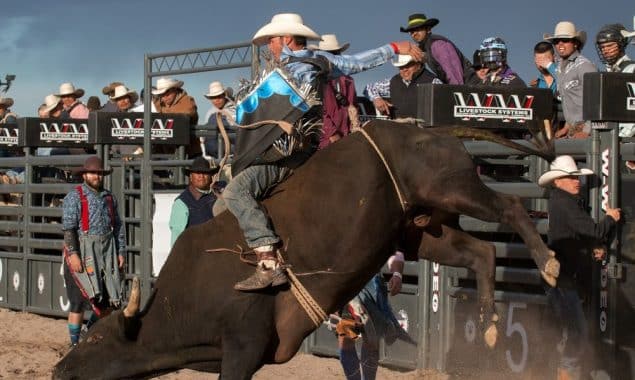Home » Business News • Dangerous Jobs • US business news » How bull riders risk being trampled to death to entertain the crowds
How bull riders risk being trampled to death to entertain the crowds
https://www.whatjobs.com/news/dangerous-jobs/dangerous-jobs-bull-riders-face-being-trampled-and-serious-injury

By Kris Paterson in Business News, posted January 4, 2024

The world of bull riding is a captivating and thrilling sport that captivates audiences around the world.
However, this high-stakes activity is not without its dangers.
It is important not to confuse bull-riding with the highly controversial bull-fighting, where the animals are often killed.
Bull Riding originated in the ranches of the American West as a test of a cowboy's skill and bravery.
It has since become a popular rodeo event in the United States, Canada, and other countries.
It's primarily a sport and entertainment activity.
READ MORE: TUC criticises Mel Stride for promoting delivery jobs for over 50s
Known as "corrida de toros" in Spanish, bullfighting has deep historical and cultural roots in Spain, Portugal, and some Latin American countries.
It's considered both an art form and a sport in these reg
In bullriding, the bull is not harmed intentionally.
After the ride, the bull is released back into its pen.
IIn bullfighting, the bull is often killed at the end of the fight, which has led to significant controversy and calls for bans on the practice.
Some regions have banned or modified the practice to be less harmful to the bulls.
Both are extremely dangerous.
The fearless athletes who participate in bull riding face a unique set of risks and challenges due to their interactions with powerful and unpredictable animals.
From bodily injuries to the psychological toll, bull riders navigate a perilous journey every time they mount a bucking bull.
In this article, we will explore the risks associated with being a bull rider and the remarkable courage and dedication required to excel in this adrenaline-pumping, but highly controversial, sport.
Bodily injuries
The most obvious risk of bull riding is the potential for severe bodily injuries.
Falling from a bucking bull can lead to broken bones, sprains, dislocations, and concussions.
The impact of hitting the ground or being trampled by the bull poses significant dangers to the rider's physical well-being.
Traumatic brain injuries
Despite the use of helmets, bull riders are still at risk of traumatic brain injuries (TBIs).
The forceful movements of the bull and the high-impact nature of the sport can result in concussions or more severe head injuries, with potential long-term consequences on the rider's health and cognitive abilities.
Goring and trampling
The bull's sharp horns and heavy hooves present a serious threat to bull riders.
In the event of a fall or entanglement with the bull, riders face the risk of being gored or trampled, leading to life-threatening injuries such as internal organ damage and severe lacerations.
Emotional and psychological stress
The mental strain of bull riding is often overlooked.
The fear and anticipation of getting on a massive, aggressive animal can lead to emotional stress, anxiety, and even post-traumatic stress disorder (PTSD) in some riders.
READ MORE: Tech Mahindra sued by US agency for alleged discrimination
Long-term health impact
Repeated falls and injuries can have long-term consequences on a bull rider's health.
Chronic pain, joint problems, and musculoskeletal issues may develop over time, affecting their overall well-being and future quality of life.
Risk of disease
Close contact with bulls puts bull riders at risk of contracting zoonotic diseases transmitted from animals to humans.
Infections and illnesses can impact the rider's health and ability to perform.
Inconsistent bull behaviour
Bulls are unpredictable animals, and each bull has a distinct temperament and behaviour.
The constantly changing nature of their movements makes it challenging for riders to anticipate and adapt to their actions.
Peer pressure and competition
The competitive nature of bull riding may drive riders to take unnecessary risks and attempt riskier manoeuvres to gain recognition or higher scores.
Peer pressure and the desire to excel in the sport can push them beyond their limits, endangering their safety.
Need Career Advice? Get employment skills advice at all levels of your career
Bull riding is an adrenaline-pumping sport that demands immense physical and mental strength from its athletes.
While it offers an exhilarating rush and the thrill of conquering a formidable opponent, bull riders face a wide array of serious risks and dangers.
From bodily injuries and traumatic brain injuries to psychological stress and long-term health impact, the sport presents significant challenges to the well-being of its participants.
Despite these risks, bull riders continue to exhibit remarkable courage, dedication, and passion for their sport, making them true athletes who push the boundaries of human endurance.
Follow us on YouTube, Twitter, LinkedIn, and Facebook














